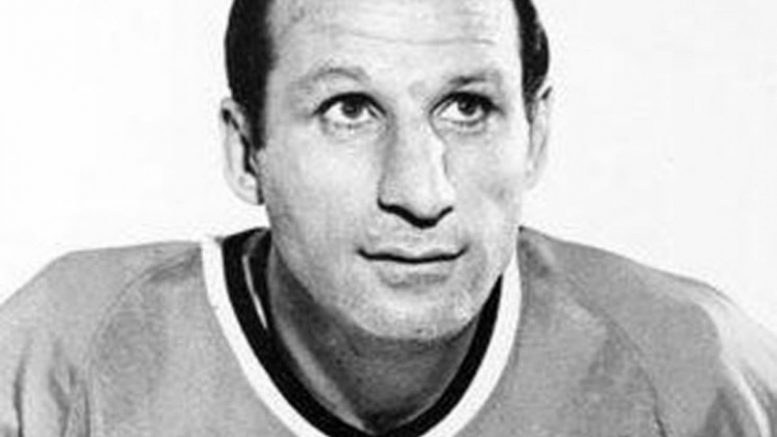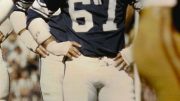Karen Zeidel’s father had vanished in a fog of unceasing headaches and tremors of rage. The tender, chivalrous gentleman her mother, Marie, met when she was 17 had deteriorated into a husk. For decades after his tough-guy hockey career, Larry Zeidel fell into a spiral of bizarre behavior and erratic actions, and it shattered the family.
Marie heard Boston University researchers wanted to study brains of deceased hockey players, especially enforcers and fighters such as Larry. Two years after his death at 86, she and her daughter found at least a measure of relief, at last, in the dispassionate words of a neuropathology report.
Brain weight: 1280 grams; whole brain; fresh
An expert panel of neurologists, neuropsychologists and researchers examined Mr. Zeidel’s case in detail and reached the following clinical consensus diagnoses: Chronic Traumatic Encephalopathy.
In the sports world, the degenerative brain condition commonly known as CTE has been a concern primarily belonging to the National Football League. But the National Hockey League is entrenched in its own growing concussion crisis, one that threatens not just the business of a league but the culture of a people.
In Canada, hockey is sacrosanct, a fast and violent sport played on frozen ponds in tiny towns by heroes venerated for their grit as much as their athleticism. The NHL built a massive business by selling the game at its epitome of speed, skill and toughness. So the growing awareness of the sport’s consequences on its players has those who play and love the game wrestling with conflicts regarding corporate responsibility, personal loyalty and adherance to a way of life.
More than 100 retired players have brought a class-action lawsuit against the NHL over brain injuries suffered while playing. Many others have considered joining but opted not to, for various reasons. Those in the suit seek medical care and a monitoring regime for the roughly 4,300 living retired players. They claim they entered into the league with clear understanding of the harm the game could cause their bodies, but not of the life-changing effects of brain trauma they suffered. They allege NHL teams provided inadequate oversight and care to treat brain injuries, all while the league promoted the game’s violence, including bare-knuckle bouts on the ice.
“There are hundreds and hundreds and hundreds of guys struggling to survive,” said Allan Walsh, a prominent NHL agent. “They are dealing with the symptoms of traumatic brain injuries. No one can tell you yet who has CTE, who doesn’t have CTE, who will get it, and who won’t. If you look just at the percentages of the NHL players who postmortem have had their brains dissected, over 90 percent have CTE. CTE is basically melting their brains. What is the NHL doing about it? These are the players that built the game to what it is today.”
The NHL has argued the players entered into the sport willfully and should have known the entirety of the risks of professional hockey. In public comments, Commissioner Gary Bettman has attempted to distance playing professional hockey from the effects of brain trauma — which, given the current landscape, means attempting to distance hockey from football.
“I think it’s fairly clear that playing hockey isn’t the same as football,” Bettman told reporters in March, after an NFL official admitted a link between football and CTE. “And as we’ve said all along, we’re not going to get into a public debate on this.”
Minnesota North Stars defenseman Brad Maxwell skates with the puck against the New York Islanders in 1981. (Focus On Sport/Focus on Sport/Getty Images) Evolving science
Dr. Robert Cantu, the co-founder of the Concussion Legacy Institute and Clinical Professor of Neurology and Neurosurgery at BU, has helped make post-mortem diagnoses from studying brains of former hockey players. Not enough hockey players’ brains have been studied to produce definitive evidence, Cantu said, but the brains that have been studied have revealed several cases of CTE. CTE has been found, Cantu said, in both enforcers and hockey players who rarely fought.
“All the cases of CTE involve repetitive head trauma, and repetitive head trauma is experienced by NHL players,” Cantu said. “So the prevailing wisdom is that it’s the repetitive head trauma that has produced CTE in those cases of NHL players where there’s been CTE diagnosed.”
While more evidence is required to make broader claims, Boston University’s findings suggest enforcers face risk of CTE. Even amid the astonishing brutality of an NFL game, never do players circle around two combatants punching each other in unprotected heads with bare fists.
“I don’t think there’s any question that ice hockey has a concussion problem,” said Chris Nowinski, the president of the Concussion Legacy Foundation. “Ice hockey has the unfortunate additional variable of having players hit their heads on the ice, which creates the biggest injuries, as well as the boards, which create their own problem. Considering the volume of former NHL players who had to retire from post-concussion syndrome, it’s clear it’s a problem.
“But whether or not the average ice hockey player has a significant risk of CTE is still an unanswered question. We know the fighters do. The guys who get in a lot of fights have risk for CTE. We don’t have a bunch of evidence yet for the average ice hockey player.”
One of the first hockey players’ brains BU studied belonged to Larry Zeidel. Zeidel played 18 professional seasons, including five in the NHL, most famously for the expansion Philadelphia Flyers. He comported himself with a dignified air away from the ice; teammates noted how he always seemed to be carrying a copy of the Wall Street Journal under one arm. He played with a fierce edge and dropped gloves to fight on command. He likely suffered more than 100 concussions, according to the BU clinical report, and lost consciousness more than 10 times. His ferocious style earned him the nickname “Rock.”
Upon retirement, Zeidel experienced debilitating headaches. His temper overtook him. He began to exhibit bizarre behavior; neighbors complained of seeing him outdoors in states of undress. He made uncharacteristically rash financial decisions that eroded his life savings. At a Flyers game, he brawled in the stands. He would fight strangers in parking lots. His marriage crumbled, and his family grew more and more distant. Late in life, he was at times homeless and frequently refused help. “It destroyed our lives,” Karen Zeidel said.
The diagnosis from BU provided clarity and a measure of closure. The findings, which the Zeidel family provided to The Post, had not been made public until now. The Zeidels shared them with the hope of raising awareness and believing it would help make the NHL accountable to other retired players.
“For me, it made a lot of the confusion and anger go away,” Marie Zeidel said. “I was very angry, because our family disintegrated and our marriage disintegrated. I was extremely angry and frustrated about that, because it wasn’t the way it was supposed to be. But I did gain some understanding, and I was able to let go of my anger toward Larry.”
Said Karen Zeidel: “In retrospect, it’s been incredibly valuable and healing. It feels like the sacrifice that my dad made for the love of hockey, not to get too sentimental, but at least there can hopefully be some meaning and change in that.”
Gary Leeman arrives for the 2015 Legends Classic game at the Air Canada Centre. (Bruce Bennett/Getty Images) Pressure to play
In the 1980s, Gary Leeman was a Toronto Maple Leafs all-star defenseman compiling the best season of his career, standing among the NHL’s leaders in points. He felt something close to invincible, and then one night, a wicked slap shot deflected off a stick, struck Leeman in the head and cracked his skull. Leeman fell to the ice and felt consciousness drift. He wondered if he would ever wake up.
“The easiest way to explain it would be, it’s the shot that changed my life,” Leeman said. “It changed my career. It changed a lot of things about me.”
Team trainers carried Leeman off the ice that night. Ringing in his ears prevented sleep. Anxiety hit Leeman about the Leafs’ next game and his stature in the sport. He had established himself as a vital player, and with that came responsibility. Hockey culture demanded resilience, doubly so for a team’s leaders. He felt pressure to prove his toughness and to maintain his position. He received no diagnostic tests, and no team officials suggested he not play.
“The protocol was, ‘Can you go? If not, we’ll replace you,’ ” Leeman said. “The team’s response was, they asked me if I could play. . . . You felt like you needed to retain your spot in the roster, or you’re going to lose it. If you got hit in the head, there was no time for you to figure out what was going on.”
So for two games after a puck fractured his skull, Leeman played, barely able to hold up his head as he skated. A Toronto trainer finally noticed he needed to rest, and Leeman missed 15 games. The ringing in his ears remained, and the effects from the deflected shot and possibly from returning to play so quickly remained for years. The traumatic nature of his concussion made him afraid to sleep, for fear he wouldn’t wake up. For years, Leeman faced debilitating fatigue, depression and panic attacks. He fights them to this day, along with memory loss, balance control issues and sensitivity to light.
In 2014, Leeman became perhaps the most high-profile retired player to lend his name to the class-action suit against the league. He says he supports the NHL, but he believes the league has not done enough to help players who suffered harm to help build a league that, according to Sports Business Journal, generated $3.7 billion in revenues during the 2013-14 season.
“I personally believe Gary Bettman has done a great job in putting a good business model together,” Leeman said. “But I think this is one thing that he needs to take another look at. This game was built on the back of the retired players. It’s the right thing to do to look after the guys that are reeling from what they should have been warned about. That’s that repetitive hits to the head are going to cause long-term issues.
“We’ve had guys unfortunately take their lives, like former players have done in the NFL. It’s very much similar. I just think what we’re doing, it’s the right thing to do. We’re on the right side of the argument. And I hope that the league can see that one day.”
Instead, the NHL has fought back. After losing its motion to dismiss last week, the league may soon be forced to consider a settlement to avoid additional public discovery, but so far, its leadership has decided to spend money on legal fees rather than pay medical expenses for its former players.
“I look at it from a common sense side,” said Brad Maxwell, one of the first nine players to lend his name to the class-action suit. “Why not quit fighting this thing? I’m not saying the NHL has to accept any [blame]. Just take care of the retired players.”
Former Maple Leafs captain Rick Vaive briefly joined the class-action suit against the NHL before pulling out days later. (Michelle Siu/AP) A small club
Leeman has helped lead more than 100 players who offered their names to the suit, a number dwarfed by the thousands of former NFL players willing to sue the league. The class-action suit will cover all retired players, so players do not have to add their name to benefit. But the lack of players directly involved also speaks to a hockey culture that implicitly — and, some say, explicitly — stifles dissent.
Those around the game say retired players fall into two categories: those who work in the NHL and those who want to. Nearly every prominent broadcaster, general manager, coach and league executive played in the NHL. Many retired players either feel indebted to the league or fear potential retribution. In Canada, hockey takes on the scope of religion. Even those suing the league make clear the regard they have for it.
“I hope we’re doing the right thing,” Maxwell said. “Growing up as a Canadian kid, one of the biggest things was playing in the NHL. The NHL is a fabulous organization. All I’m saying is, the NHL needs to sit down and look at the retired players. When I was playing, the NHL and NHL Players Association, they take care of you completely. When you quit and you’re done, they’re done with you.”
Hockey is both more insular and more international than other professional team sports. European and Russian players often lack a nuanced understanding of American litigation. At the same time, many North American players may fear repercussions on a family name. Karen Zeidel hesitated to make her father’s diagnosis public for many reasons. One of them was concern her hockey-playing nephew could be “potentially blackballed.”
“I know it sounds paranoid and ridiculous,” Karen Zeidel said, “but it’s not.”
Many retired players count on appearance fees and perks derived from the NHL Alumni Association. Some fear they could lose both by joining the suit, even if the association says it has never threatened to cut off a retiree for joining the suit.
In November 2013, former Maple Leafs star Rick Vaive momentarily joined the suit. Days after his association became public, Vaive vociferously pulled out. Trevor Whiffen, Vaive’s lawyer, said Baltimore-based lawyer Steve Silverman, part of the co-counsel on the players’ side, contacted Vaive about joining the suit. Vaive believed it would be a workers’ comp claim in California, Whiffen said, and he did not know he had aligned himself against the league. Whiffen said he never saw a copy of the complaint.
“He didn’t want to be a plaintiff against the National Hockey League, where he played 15 years and was a 50-goal scorer,” Whiffen said. “The allegations Silverman made were irresponsible, as far as I’m concerned. You don’t make scandalous allegations without getting specific instructions from your clients to say that.”
Said Silverman: “Not only was Rick Vaive 100 percent behind the lawsuit, he had a full opportunity to review each and every allegation in the lawsuit before it was filed. Unfortunately, and understandably, there was a tremendous amount of backlash on him in Canada. And he crumbled quickly under the pressure from the fans, the league and the media.”
NHL Commissioner Gary Bettman speaks before the 2016 All-Star Game skills competition in Nashville. (Mark Humphrey/AP) A nervous system
The litigation may eventually change how the NHL handles in-game concussions. Dr. Frank Conidi, the Florida Panthers’ team neurologist, said the NHL lags behind the NFL in dealing with concussions and returning players to the playing surface. The NHL formed a concussion work group in 1997, and to this day, Conidi said, the NHL does not have a neurologist on the panel.
“They’re definitely far behind the NFL,” Conidi said. “That’s because they haven’t had the legal action going on to the point where the NFL has. The biggest issue is lack of input by neurologists. It’s not mandatory. The NFL requires a player to be diagnosed by a neurologist before they go back. [Neurologists] just do a better job with our examinations, because it’s our specialty.”
Without question, hundreds of NHL retirees played without any concussion protocol, and hundreds deal with issues stemming from brain damage today. Walsh said one client, a former player who fought infrequently, called him in a panic after he could not remember how to drive home from a store. The player would sometimes forget his children’s birthdates. He told Walsh he suffered four concussions “officially,” but at least 15 in reality.
In the class-action suit, players say they were damaged by a sense of duty to perform violence they did not know would be so catastrophic once they stopped playing. Larry Zeidel died proud of the way he played hockey, because it was all he ever knew and all that had been asked of him. He died ignorant of the costs, the explanation his family learned after his death.
“First, I played some senior hockey in Quebec City, and we could play well and win, but the fans would rather have us involved in a real brawl and lose the game,” Zeidel once said, according to a Philadelphia Inquirer obituary. “There were a lot of rugged guys in the league at that time, too, so maybe it was partly a matter of survival.
“The other thing is that there’s the big thing of being young and having stars in your eyes. The clubs themselves are as much or more to blame. They play up the tough guys. Guts, guts, guts is all you hear from a lot of coaches and managers, even as early as junior. I was playing for some coaches and managers who would tell me, ‘Go get him.’ So I did.”
Source: www.washingtonpost.com





Be the first to comment on "Former Players Are Suing the NHL Over Concussions, but Remain Loyal to Hockey"